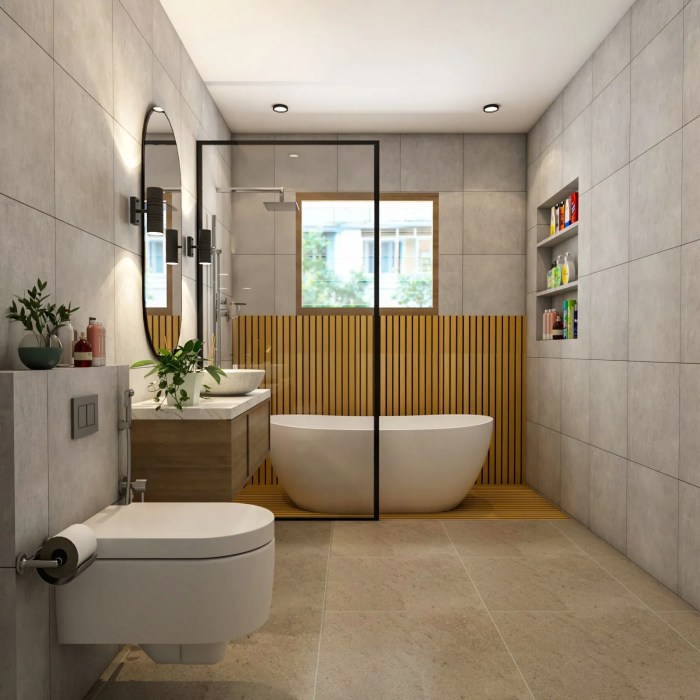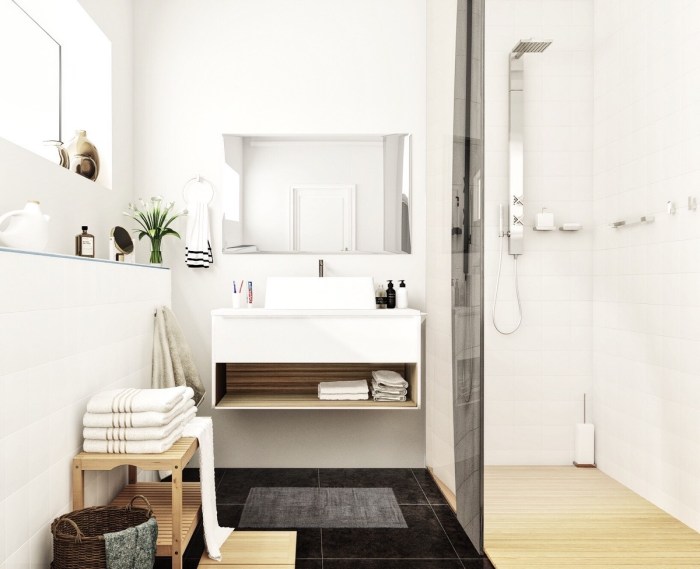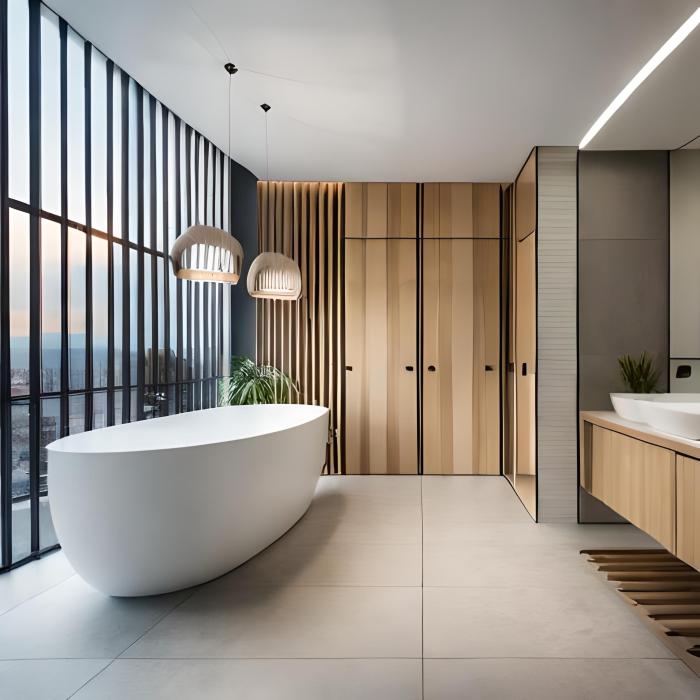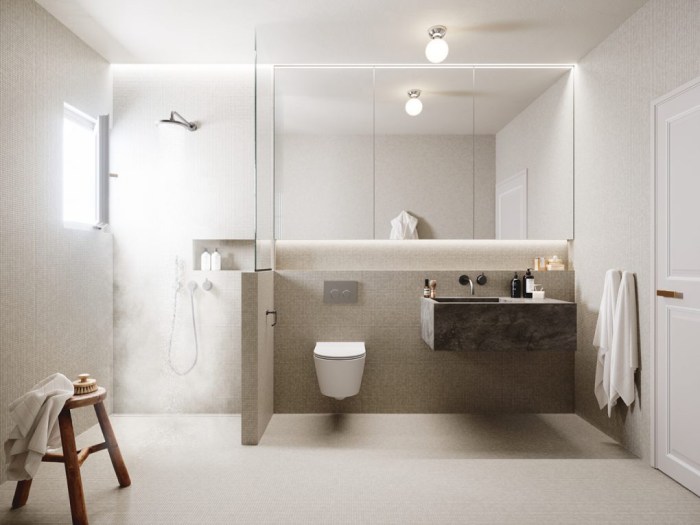Imagine stepping into a haven of serenity: a Nordic bathroom, where minimalist aesthetics meet the soothing textures of carefully selected tiles. This design philosophy, deeply rooted in Scandinavian principles of functionality and natural beauty, translates into bathrooms that are both visually stunning and incredibly practical. We’ll explore the core tenets of Nordic bathroom design, focusing on tile choices, lighting, space optimization, and the harmonious blend of modern and traditional elements to create a truly tranquil retreat.
The Nordic aesthetic prioritizes clean lines, a muted color palette often featuring whites, grays, and soft blues, and the generous use of natural materials. Tile selection plays a crucial role in achieving this, with materials like ceramic, porcelain, and natural stone offering varied textures and visual appeals. From subtle geometric patterns to the calming effect of large, neutral-toned tiles, the possibilities are extensive.
Understanding the interplay of tile materials, grout color, lighting schemes, and space planning is key to realizing the full potential of a Nordic bathroom.
Defining Nordic Bathroom Design Aesthetics

Nordic bathroom design, a branch of the broader Scandinavian design movement, prioritizes functionality, minimalism, and a connection to nature. It eschews ostentation in favor of clean lines, simple forms, and a calming atmosphere conducive to relaxation and rejuvenation. This aesthetic translates seamlessly into the bathroom, a space often associated with both hygiene and personal sanctuary. The overall effect is one of understated elegance and serene tranquility.
The core principles of Nordic design, such as functionality, minimalism, and natural light, are paramount in creating a Nordic-style bathroom. The emphasis is on creating a space that is both practical and aesthetically pleasing, using high-quality, durable materials that age gracefully. Clutter is minimized, and every element serves a purpose, contributing to the overall sense of calm and order.
Nordic Bathroom Color Palettes
The color palettes employed in Nordic bathroom design typically feature a restrained range of muted tones, drawing inspiration from the natural landscape of Scandinavia. Neutral shades dominate, with whites, grays, and various shades of beige forming the foundation. These are often complemented by subtle accents of natural wood tones, such as light oak or birch, or muted blues and greens reminiscent of the sea and forests.
Black is used sparingly, often as a contrasting element in fixtures or accents to emphasize the clean lines and simplicity of the design. The overall effect is a sense of airy spaciousness and light, reflecting the long, bright summer days characteristic of Nordic regions. Bright, saturated colors are avoided, maintaining the overall sense of serenity.
Natural Materials in Nordic Bathroom Tile Design
Natural materials are central to the Nordic aesthetic, reflecting a deep respect for nature and sustainability. In bathroom tile choices, this translates to a preference for materials like natural stone, particularly light-colored marble or limestone, known for their durability and inherent beauty. Large format tiles are frequently used to create a sense of spaciousness, minimizing grout lines and maintaining a clean, uncluttered look.
Ceramic tiles mimicking the appearance of natural stone or wood are also popular choices, offering a more affordable and practical alternative while still capturing the essence of the Nordic aesthetic. The textures are generally smooth, although subtle variations in tone and veining are embraced to add a touch of visual interest without compromising the overall sense of calm.
Avoidance of overly glossy or reflective surfaces is key; matte or honed finishes are preferred.
Nordic Bathroom Mood Board
Imagine a bathroom bathed in soft, natural light. The walls are clad in large, matte-finish, light gray limestone tiles, their subtle veining adding a touch of visual interest. The floor is covered in similarly toned, but slightly warmer, beige limestone tiles. A freestanding bathtub, crafted from white porcelain with clean, simple lines, sits against one wall. A wooden vanity, made from light oak with a natural, oiled finish, features a simple, integrated sink.
The countertop is made of a honed, light gray marble, its cool texture contrasting beautifully with the warmth of the wood. Soft, fluffy white towels are draped neatly over a minimalist towel rack made from brushed nickel. The overall color palette is a harmonious blend of light grays, warm beiges, and the natural tones of the oak wood.
The textures range from the smooth, cool touch of the stone tiles to the warm, slightly rough texture of the oiled oak. The overall mood is one of serenity, calm, and understated elegance. The design prioritizes simplicity, functionality, and a connection to the natural world.
Tile Selection and Application in Nordic Bathrooms

The selection and application of tiles are crucial in achieving the desired aesthetic and functionality within a Nordic bathroom. The minimalist and nature-inspired design philosophy demands careful consideration of material, color, and pattern to create a space that is both serene and practical. The unique climate of Nordic regions also necessitates durable and water-resistant materials capable of withstanding fluctuations in temperature and humidity.
Tile Material Comparison
The Nordic bathroom environment presents specific challenges for tiling materials. High humidity, potential temperature swings, and the desire for a clean, modern look necessitate a discerning choice. Ceramic, porcelain, and natural stone each offer unique properties that align differently with Nordic design principles. Ceramic tiles, known for their affordability and wide variety of colors and finishes, are a viable option, particularly for less demanding areas.
However, they are generally less durable and water-resistant than porcelain. Porcelain tiles, on the other hand, boast superior durability, water resistance, and stain resistance due to their denser structure and lower porosity. This makes them ideal for high-traffic areas and floors. Natural stone tiles, such as marble or slate, offer a luxurious and unique aesthetic, perfectly complementing the natural elements favored in Nordic design.
However, they are more expensive, require more maintenance, and may be less durable in high-moisture environments than porcelain. The choice depends on budget, desired aesthetic, and level of maintenance desired.
Tile Patterns and Layouts
The arrangement of tiles significantly impacts the overall visual effect. Nordic design favors simplicity and clean lines. Common patterns and layouts include:
| Tile Size | Color | Material | Layout Description |
|---|---|---|---|
| 60×60 cm | Off-white | Porcelain | Large format tiles laid in a straightforward running bond pattern, creating a sense of spaciousness. |
| 30×30 cm | Light grey | Ceramic | Smaller tiles arranged in a classic brick bond pattern, offering a subtle textural variation. |
| 10×10 cm | Various shades of blue and white | Ceramic | Small mosaic tiles creating a visually interesting accent wall, perhaps around a shower or bathtub. |
| 15×90 cm | Neutral beige | Porcelain | Rectangular tiles laid vertically to enhance the height of the room, common in smaller bathrooms. |
Grout Color Selection and Impact
Grout color significantly affects the overall visual perception of the tiled surface. In Nordic bathrooms, where minimalism is key, lighter grout colors, such as off-white, light grey, or even a subtle shade of the tile itself, are often preferred. This creates a seamless and uncluttered look, allowing the tile pattern and color to take center stage. Darker grout colors, while visually striking, can make the space appear smaller and more cluttered, contradicting the airy feel characteristic of Nordic design.
The choice of grout color should complement, not compete with, the chosen tiles.
Tile Installation Process
The installation process varies slightly depending on the type of tile. However, some general steps apply across the board. Firstly, the surface must be properly prepared, ensuring it is clean, level, and free from debris. Secondly, a suitable adhesive must be selected, considering the tile material and substrate. For porcelain and natural stone, a high-performance adhesive is crucial for optimal bond strength.
The tiles are then carefully applied to the adhesive, ensuring even spacing using spacers. Grout is applied once the adhesive has cured, and excess grout is removed before it sets. Finally, the tiles are sealed to enhance water resistance and durability, especially crucial in the humid bathroom environment. Professional installation is often recommended, particularly for natural stone tiles, to ensure optimal results and longevity.
Incorporating Lighting and Fixtures

The successful integration of lighting and fixtures is paramount in achieving the serene and functional ambiance characteristic of a Nordic bathroom. Careful consideration of light sources, their placement, and the selection of fixtures that complement the overall design aesthetic are crucial for maximizing both the visual appeal and practical usability of the space. The interplay of light and materials, particularly the chosen tiles, significantly impacts the perceived texture and color, enhancing the overall design.The goal is to create a space that feels both invigorating and relaxing, mimicking the natural light shifts experienced in Nordic countries throughout the year.
This is achieved through a layered approach to lighting, combining ambient, task, and accent lighting to create a versatile and mood-setting environment.
Lighting Schemes for Nordic Bathrooms
Nordic bathroom lighting schemes prioritize natural light whenever possible, often incorporating large windows or skylights. However, artificial lighting is essential for evening and winter months. The primary goal is to emulate the soft, diffused light of a Nordic day, avoiding harsh shadows and overly bright illumination. This is typically achieved through a combination of diffused overhead lighting, softer wall-mounted sconces, and potentially accent lighting to highlight specific features, such as a statement tile backsplash or a freestanding bathtub.
The color temperature of the lighting is also critical; warmer tones (around 2700-3000K) are preferred to create a cozy and inviting atmosphere, while cooler tones (around 4000-5000K) can be used in areas requiring greater visibility, such as the vanity area. The use of dimmers allows for adjustable brightness, adapting the lighting to different times of day and moods.
Lighting Plan for a Nordic Bathroom
Consider a bathroom with a size of approximately 8ft x 6ft. A recessed LED panel light fixture (4000K) in the ceiling provides general ambient lighting, ensuring even illumination throughout the space. Two wall-mounted LED sconces (2700K) flanking a mirror above a vanity offer task lighting for grooming, while also adding a warm glow to the space. Finally, an under-cabinet LED strip light (2700K) illuminates the vanity countertop, preventing harsh shadows and highlighting any decorative elements.
This layered approach ensures adequate illumination for all activities while maintaining a soft, inviting atmosphere. The use of dimmers allows for adjustment of brightness according to preference and time of day.
Suitable Bathroom Fixtures for Nordic Design
The selection of bathroom fixtures is equally important in realizing a successful Nordic design. The materials and styles should reflect the minimalist aesthetic, emphasizing clean lines, natural materials, and a sense of understated elegance.
- Sinks: A minimalist rectangular or oval sink made of matte white ceramic or concrete, or a vessel sink made of natural stone (such as marble or granite) would complement the style. The absence of excessive ornamentation is key.
- Faucets: Sleek, single-lever faucets with a brushed nickel or matte black finish provide a modern touch. Consider faucets with a minimalist design and smooth, uninterrupted lines.
- Toilets: Wall-hung toilets with a concealed cistern create a clean and uncluttered look, maximizing floor space and emphasizing the minimalist aesthetic. Choose a toilet with a sleek, elongated design in white or a muted, neutral color.
Lighting’s Impact on Tile Textures and Colors
The choice of lighting significantly influences the perceived texture and color of the tiles. Warmer light sources tend to enhance the richness and depth of colors, particularly in darker tiles, making them appear more inviting and luxurious. Cooler light sources, on the other hand, can make colors appear slightly more muted and can highlight subtle variations in texture. For example, a matte tile will appear smoother under warmer light, while a textured tile will show its three-dimensionality more clearly under cooler light.
The interplay of light and shadow created by different lighting schemes can also enhance or diminish the perceived texture of the tiles. Direct lighting might highlight imperfections, whereas diffused light softens the appearance, creating a more harmonious and calming effect. Therefore, careful consideration of both the tile characteristics and the lighting scheme is essential to achieve the desired visual effect.
Space Planning and Functionality

Optimizing space in a Nordic bathroom, particularly smaller ones, is paramount. The minimalist aesthetic, while visually appealing, necessitates careful consideration of storage and efficient layouts to maintain functionality and avoid a cluttered feel. Understanding spatial ergonomics and incorporating smart design choices are crucial for creating a relaxing and practical bathroom experience.The limited square footage common in many Nordic homes necessitates a strategic approach to bathroom design.
Every element must serve a purpose, and space must be used vertically as well as horizontally. This involves careful consideration of the placement of fixtures, storage solutions, and the use of reflective surfaces to enhance the sense of spaciousness. The principles of Scandinavian design—clean lines, natural materials, and a focus on functionality—directly inform the spatial planning process.
Small Nordic Bathroom Layout: Maximizing Functionality and Storage
A small Nordic bathroom (approximately 4m x 2m) can be effectively designed to maximize functionality. The layout prioritizes a walk-in shower to eliminate the space occupied by a shower curtain or door. A floating vanity with integrated drawers and a mirrored medicine cabinet provides ample storage without visually overwhelming the space. A tall, narrow linen closet, ideally positioned near the shower, efficiently stores towels and toiletries.
The toilet is positioned opposite the vanity, creating a natural separation of zones. The wall above the toilet can incorporate open shelving for displaying decorative items or frequently used items, adding visual interest without compromising space. The floor is tiled in large, light-colored tiles (e.g., 60x60cm matte white porcelain) to create a sense of spaciousness and cleanliness.
The shower area utilizes smaller, darker grey tiles (e.g., 20x20cm) for contrast and to define the space.
Text-Based Floor Plan: Small Nordic Bathroom
Imagine a rectangular space. Entering from the door, the toilet is positioned on the far left wall. Opposite the toilet, on the right wall, is a floating vanity with a mirrored medicine cabinet above. A walk-in shower occupies the back wall, with a glass enclosure. A tall, narrow linen closet is positioned to the left of the shower.
The entire floor, excluding the shower area, is tiled with large, light-colored tiles. The shower area features smaller, darker grey tiles.
Larger Nordic Bathroom Layouts: Tile as a Design Element
Larger Nordic bathrooms offer greater flexibility in layout and the strategic use of tile as a design element. Several layouts can be considered, each offering distinct advantages.One approach features a freestanding bathtub as a focal point, positioned centrally or against a feature wall. The surrounding floor and walls could utilize large, neutral-toned tiles, creating a sense of calm and spaciousness.
A contrasting tile pattern or color could be used in a smaller zone, such as a shower alcove or vanity backsplash, to add visual interest.Another layout incorporates a double vanity, ideal for couples. This layout could utilize a combination of tiles: large format tiles for the main floor area and smaller mosaic tiles for the vanity backsplash. A separate walk-in shower with glass enclosure maintains the feeling of openness.
Different tile colors and textures can delineate different areas within the bathroom, creating visual zones without the need for physical partitions.A third option focuses on creating a spa-like atmosphere. This could involve using natural stone tiles, such as marble or slate, on the floor and walls. A large walk-in shower with a rain shower head and a built-in bench creates a luxurious feel.
The use of textured tiles can add depth and visual interest to the space. In each case, the tile selection should complement the overall Nordic aesthetic, emphasizing natural materials and clean lines.
Blending Modern and Traditional Elements
The inherent beauty of Nordic design lies in its ability to seamlessly integrate seemingly disparate elements. While minimalism and functionality are cornerstones of modern Nordic aesthetics, a rich history of craftsmanship and natural materials informs a traditional approach. Successfully blending these styles within a bathroom setting requires a thoughtful consideration of materials, particularly tile, to create a space that feels both contemporary and timeless.
This involves understanding the nuances of both styles and using tile as a powerful tool to bridge the gap.The incorporation of modern design elements into a traditional Nordic bathroom can be achieved through several strategic approaches. This involves a careful selection of materials, colors, and shapes that echo both the clean lines of modern design and the warmth of traditional Nordic aesthetics.
The key is to find a balance, preventing either style from overwhelming the other.
Modern and Traditional Tile Choices
Different tile choices can significantly impact the overall aesthetic of a Nordic bathroom, allowing for a subtle or dramatic blend of modern and traditional styles. Large format, minimalist tiles in neutral tones such as white, light grey, or beige, immediately evoke a sense of modern simplicity. These tiles can be paired with smaller, textured tiles, perhaps with subtle patterns inspired by traditional Nordic weaving or wood grain, to introduce a traditional touch.
For instance, a large format, matte white tile on the walls could be complemented by smaller, hexagonal tiles with a subtle geometric pattern in a muted grey around the shower area. This juxtaposition creates visual interest without disrupting the overall calm atmosphere.
Using large format tiles for the majority of the wall space creates a sense of spaciousness, while smaller, textured tiles used as accents introduce visual complexity and a nod to traditional craftsmanship.
Decorative Tile Accents in a Nordic Bathroom
Decorative tile accents can act as focal points, elevating the design and adding a layer of personality. Instead of relying on extensive tiling patterns, consider using decorative tiles sparingly. A small section of hand-painted tiles depicting Nordic flora or fauna, subtly integrated into a larger expanse of plain tiles, can add a touch of traditional charm without overwhelming the space.
Alternatively, a border of patterned tiles above the bathtub or around a mirror can create a visually appealing frame. These accents serve as reminders of the rich heritage of Nordic design, while the overall minimalist approach keeps the space feeling modern and uncluttered.
Strategic placement of decorative tiles can add a unique and personal touch without compromising the overall aesthetic balance. Consider using them to highlight specific features, such as a vanity or shower niche.
Design Concept: Modern Traditional Nordic Bathroom
This design concept utilizes a palette of whites, greys, and natural wood tones to create a calming and inviting atmosphere. The main walls are clad in large format, matte white tiles, creating a clean and spacious feel. A feature wall behind the vanity incorporates smaller, textured tiles in a light grey, mimicking the look of woven textiles. The shower floor is tiled with hexagonal tiles in a slightly darker grey, adding a touch of visual interest.
Finally, a narrow border of hand-painted tiles depicting stylized Nordic wildflowers is incorporated above the bathtub, serving as a subtle nod to traditional craftsmanship. The overall effect is a balanced blend of modern minimalism and traditional Nordic charm, unified by the careful selection and application of tiles.
The interplay of textures and scales in the tile choices creates a sophisticated and harmonious balance between modern and traditional Nordic styles.
Final Thoughts
Designing a Nordic bathroom with tile is more than just selecting aesthetically pleasing materials; it’s about crafting a space that embodies tranquility and functionality. By thoughtfully considering the interplay of color palettes, natural materials, lighting, and spatial arrangements, one can create a sanctuary that reflects the essence of Scandinavian design. From the calming effect of natural stone tiles to the subtle elegance of minimalist fixtures, each element contributes to the overall atmosphere of serenity and well-being.
The result is a bathroom that is not only visually appealing but also a haven for relaxation and rejuvenation.
Query Resolution
What are some popular tile sizes for a Nordic bathroom?
Large format tiles (e.g., 12×24 inches or larger) are popular for their clean lines and minimalist aesthetic. Smaller, mosaic tiles can also be used effectively as accents.
How do I choose the right grout color?
Light-colored grout generally creates a cleaner, more spacious feel. Matching grout to the tile color creates a seamless look, while contrasting grout can add visual interest.
Are underfloor heating systems compatible with all tile types?
Underfloor heating works well with most tile types, but some natural stones may have limitations. Consult a professional installer for specific tile compatibility.
How can I incorporate plants into a Nordic bathroom design?
Introduce low-maintenance, humidity-tolerant plants in simple pots to enhance the natural feel of the space. Consider placing them on shelves or windowsills.
What are some sustainable tile options for a Nordic bathroom?
Recycled glass tiles, porcelain tiles made with recycled content, and sustainably sourced natural stone are all environmentally friendly choices.
